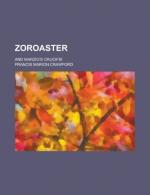Marzio was tall and very thin. His limbs seemed to move rather by the impulse of a nervous current within than by any development of normal force in the muscles, and his long and slender fingers, naturally yellow and discoloured by the use of tools and the handling of cements, might have been parts of a machine, for they had none of that look of humanity which one seeks in the hand, and by which one instinctively judges the character. He was dressed in a woollen blouse, which hung in odd folds about his emaciated frame, but which betrayed the roundness of his shoulders, and the extreme length of his arms. His apprentice, Gianbattista Bordogni, wore the same costume; but beyond his clothing he bore no trace of any resemblance to his master. He was not a bad type of the young Roman of his class at five-and-twenty years of age. His thick black hair curled all over his head, from his low forehead to the back of his neck, and his head was of a good shape, full and round, broad over the brows and high above the orifice of the ear. His eyes were brown and not over large, but well set, and his nose was slightly aquiline, while his delicate black moustache showed the pleasant curve of his even lips. There was colour in his cheeks, too—that rich colour which dark men sometimes have in their youth. He was of middle height, strong and compactly built, with large, well-made hands that seemed to have more power in them, if less subtle skill, than those of Maestro Marzio.
“Remember what I told you about the second indentation of the acanthus,” said the elder workman, without looking round; “a light, light hand—no holes in this work!”
Gianbattista murmured a sort of assent, which showed that the warning was not wanted. He was intent upon the delicate operation he was performing. Again the hammers beat irregularly.
“The more I think of it,” said Marzio after the pause, “the more I am beside myself. To think that you and I should be nailed to our stools here, weekdays and feast-days, to finish a piece of work for a scoundrelly priest—”
“A cardinal,” suggested Gianbattista.
“Well! What difference is there? He is a priest, I suppose—a creature who dresses himself up like a pulcinella before his altar—to—”
“Softly!” ejaculated the young man, looking round to see whether the door was closed.
“Why softly?” asked the other angrily, though his annoyance did not seem to communicate itself to the chisel he held in his hand, and which continued its work as delicately as though its master were humming a pastoral. “Why softly? An apoplexy on your softness! The papers speak as loudly as they please—why should I hold my tongue? A dog-butcher of a priest!”
“Well,” answered Gianbattista in a meditative tone, as he selected another chisel, “he has the money to pay for what he orders. If he had not, we would not work for him, I suppose.”
“If we had the money, you mean,” retorted Marzio. “Why the devil should he have money rather than we? Why don’t you answer? Why should he wear silk stockings—red silk stockings, the animal? Why should he want a silver ewer and basin to wash his hands at his mass? Why would not an earthen one do as well, such as I use? Why don’t you answer? Eh?”




